| Location | Beirut, Lebanon |
|---|---|
| Coordinates | 33°53′49″N35°29′59″E / 33.89694°N 35.49972°E |
The hippodrome of Berytus was a circus in the Roman colony of Berytus (modern-day Beirut). It is one of two hippodromes in Beirut.
| Location | Beirut, Lebanon |
|---|---|
| Coordinates | 33°53′49″N35°29′59″E / 33.89694°N 35.49972°E |
The hippodrome of Berytus was a circus in the Roman colony of Berytus (modern-day Beirut). It is one of two hippodromes in Beirut.
The hippodrome was built close to the port and forum of Berytus (modern Beirut). [1] It was one of the largest in the Levant, occupying an area of 3500 m2, [1] and was probably similar in overall design to the Circus Maximus in Rome, comprising starting gates and a circuit of two straight tracks connected by a semicircular end. The circus was mostly used for chariot racing, which was an immensely popular and highly partisan spectator sport throughout the Roman Empire; the track would have been surrounded by seating tiers for spectators. The Berytus hippodrome is mentioned in the anonymous, late 4th century Expositio totius mundi et gentium ("A description of the world and its people") as one of the five best racing circuits in the Levant, the others being at Antioch, Laodicea, Caesarea and Tyrus. [2]
During the 6th and the 7th centuries of the Byzantine Empire, violent factional and political disturbances at circuses (such as the Nike riots in Constantinople) led to their gradual abandonment as places of costly, officially subsidised mass entertainment. The hippodrome at Berytus fell into disuse and disrepair.
Its stone was later mined and reused in the construction of other buildings, according to archeologist Lee Levine. Its outline remained sufficiently clear in the 20th century for identification as a hippodrome by the archaeologist Robert du Mesnil du Buisson. [3] Its groundworks were partially excavated in 1988. An approximately 90-meter section of wall has been uncovered, alongside the straight, and the foundations of seating tiers at the semi-circular end. [4]
The hippodrome site is near the Maghen Abraham Synagogue in Wadi Abu Jamil, the historic, Jewish quarter of Beirut. [1]
In 2009, the site was officially listed in the general inventory of historic buildings, and the Culture Minister Tamam Salam ruled that it should be preserved in situ and turned into a tourist landmark. [4]
According to an article appearing in the French daily, L'Orient-Le Jour , Gaby Layoun, the Culture Minister at the time, approved in March 2012 plans for a luxury residential complex to be built over the ruins of Beirut’s Roman Hippodrome, bypassing the recommendations of three of his predecessors: Tarek Mitri, Salim Wardé, and Tammam Salam. [5] [6] The Association for the Protection of the Lebanese Heritage (APLH) organized protests as an attempt to reverse the Culture Ministry's decision to allow the building over the hippodrome. [7] Following the litigation brought by APLH, the court suspended on May 31, 2012 the Culture Ministry's decision, N˚ 849, to dismantle the Roman Hippodrome that would have allowed for the construction of a building project on the site. [8] The site was protected until 2015 when construction began again.

Beirut is the capital and largest city of Lebanon. As of 2014, Greater Beirut has a population of 2.5 million, which makes it the third-largest city in the Levant region and the thirteenth-largest in the Arab world. The city is situated on a peninsula at the midpoint of Lebanon's Mediterranean coast. Beirut has been inhabited for more than 5,000 years, making it one of the oldest cities in the world.
Hippodrome is a term sometimes used for public entertainment venues of various types. A modern example is the Hippodrome which opened in London in 1900 "combining circus, hippodrome, and stage performances".

Achrafieh is an upper-class area in eastern Beirut, Lebanon. In strictly administrative terms, the name refers to a sector (secteur) centred on Sassine Square, the highest point in the city, as well as a broader quarter (quartier). In popular parlance, however, Achrafieh refers to the whole hill that rises above Gemmayze in the north and extends to Badaro in the south, and includes the Rmeil quarter.
A hippodrome was an ancient Grecian horse and chariot racing course and arena. Hippodrome or Hipódromo may also refer to:

A Roman circus was a large open-air venue used mainly for chariot races, although sometimes serving other purposes. It was similar to the ancient Greek hippodrome. Along with theatres and amphitheatres, circuses were one of the main entertainment venues at the time.
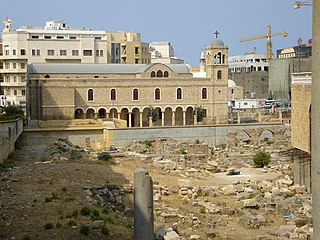
Berytus, briefly known as Laodicea in Phoenicia or Laodicea in Canaan from the 2nd century to 64 BCE, was the ancient city of Beirut from the Roman Republic through the Roman Empire and Early Byzantine period/late antiquity. Berytus became a Roman colonia that would be the center of Roman presence in the eastern Mediterranean shores south of Anatolia. The veterans of two Roman legions under Augustus were established in the city, that afterward quickly became Romanized and was the only fully Latin-speaking city in the Syria-Phoenicia region until the fourth century. Although Berytus was still an important city after earthquakes, around 400 CE Tyre was made the capital of the Roman province of Phoenicia. "Of the great law schools of Rome, Constantinople, and Berytus", the law school of Berytus stood "pre-eminent". The Code of Justinian was mostly created in this school.

Saint Joseph University of Beirut is a private Roman Catholic research university located in Beirut, Lebanon, which was founded in 1875 by French Jesuit missionaries and subsidized by the Government of France during the time when Lebanon was under Ottoman rule. It is widely recognized as one of the leading and most prestigious academic institutions in Lebanon and Middle East. USJ's roster of graduates includes seven of independent Lebanon's thirteen Presidents, a Speaker of the Parliament of Lebanon, two Presidents of the Council of Ministers of Lebanon, Governors of the Banque du Liban, hundreds of legislators and ministers, numerous judges, and high-ranking civil servants, among them Commanders of the Lebanese Armed Forces and executives of the Internal Security Forces. As the oldest and foremost French university in Lebanon, it not only promotes Lebanese culture but also upholds a policy of equal admission opportunity without consideration of ethno-religious affiliations. Furthermore, it advocates trilingual education, offering instruction in Arabic, French, and English. Additionally, it is known in Lebanon and the Middle East for its prominent university hospital, the Hôtel-Dieu de France, and for its prestigious and historical Faculty of Law, modern Lebanon's oldest law school and the first law school in Lebanon since the ancient Roman law school of Berytus.

Beirut, the capital of Lebanon, is home to two hippodromes, a historic one from the Roman era and a modern one that was built in the late 19th century.

Phoenicia under Roman rule describes the Phoenician city states ruled by Rome from 64 BCE to the Muslim conquests of the 7th century. The area around Berytus was the only Latin speaking and Romanized part of Aramaic-speaking Phoenicia.

L'Orient-Le Jour is a French-language daily newspaper in Lebanon. Its English-language edition is L'Orient Today.
Gaby Emile Layoun was the Lebanese Minister of Culture, announced as part of the cabinet led by Najib Mikati. He represents the Free Patriotic Movement. Layoun is married and has two children. He holds a diploma in engineering, a Lebanese Baccalaureate in mathematics (1982) and a Sacred Heart of the city of Zahle.
The Beirut Rose ('Meideauri'), also known by its French name Rose de Beyrouth, was developed by the French rose producer, Meilland International SA, and unveiled at the ninth Garden Show & Spring Festival, which is held annually at the Beirut Hippodrome in Lebanon.
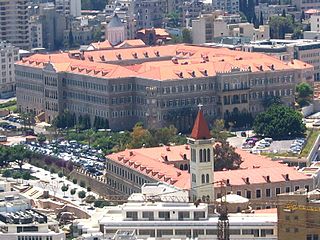
The Phoenician port of Beirut, also known as the Phoenician Harbour of Beirut and archaeological site BEY039 is located between Rue Allenby and Rue Foch in Beirut, Lebanon. Studies have shown that the Bronze Age waterfront lay around 300 metres (330 yd) behind the modern port due to coastal regularisation and siltation. It was excavated and reported on by Josette Elayi and Hala Sayegh in 2000 and determined to date to the Iron Age III and Persian periods. Two nineteenth-century Ottoman docks were also unearthed during construction, just to the north of this area at archaeological sites BEY018 and BEY019.
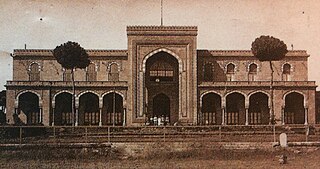
The Pine Residence, located in the Horsh district of Beirut, is the official residence of the French ambassador to Lebanon. The palace holds particular historical importance since General Henri Gouraud declared the creation of the state of Greater Lebanon on September 1, 1920, from its porch.
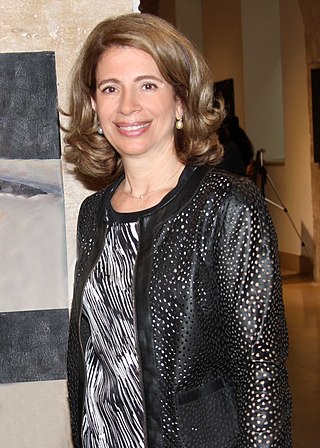
Lama Badreddine Salam is a Lebanese activist and is married to Tammam Saeb Salam, former Prime Minister of Lebanon, and served as Acting First Lady of Lebanon while her husband was Acting President of Lebanon. She is an educational counselor and activist for several non-governmental organizations (NGOs) in Lebanon.

The Roman Berytus are located in the middle of downtown Beirut, Lebanon between Banks Street and Capuchin Street. The remains of a Roman bath of Berytus now surrounded by government buildings were found and conserved for posterity.

The Tyre Hippodrome is a UNESCO World Heritage site of the city of Tyre in south Lebanon dating back to the Second century AD The Expositio, a description of the world written in the second half of the fourth century by an unknown writer about circuses in the Roman empire, names the Tyre Hippodrome as one of the five best racecourses in the Levant.
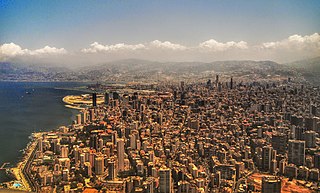
The earliest settlement of Beirut was on an island in the Beirut River, but the channel that separated it from the banks silted up and the island ceased to be. Excavations in the downtown area have unearthed layers of Phoenician, Hellenistic, Roman, Byzantine, Arab, Crusader, and Ottoman remains.
A total of 718 candidates contested the 2022 Lebanese general election, running on 103 lists.
The three previous Culture Ministers, Mitri, Wardé, and Salam criticized Layoun's move and reiterated the importance of protecting and preserving the archeological site